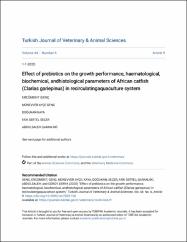Effect of prebiotics on the growth performance, haematological, biochemical, and histological parameters of African catfish (Clarias gariepinus) in recirculating aquaculture system

Göster/
Tarih
2020Yazar
Genç, ErcümentGenç, Münevver Ayçe
Kaya, Doğukan
Seçer, Faik Sertel
Qaranjiki, Abdolsaleh
Güroy, Derya
Üst veri
Tüm öğe kaydını gösterKünye
Genç, E., Genç, M., Kaya, D., Seçer, F., Qaranjiki, A., Güroy, D. (2020). Effect of prebiotics on the growth performance, haematological, biochemical, and histological parameters of African catfish (Clarias gariepinus) in recirculating aquaculture system. Turkish Journal of Veterinary and Animal Sciences, 44(6), 1222 - 1231. https://doi.org/10.3906/vet-2005-106Özet
In this study, African catfish (Clarias gariepinus) was investigated under controlled conditions in recirculating aquaculture system (RAS). The experiment tested the effects of three different dietary prebiotics (FOS: fructooligosaccharide, GOS: galactooligosaccharide, and MOS: mannanoligosaccharide) in two levels (1 g/kg and 2 g/kg) and a control diet on the growth performance, survival rate, haematological and biochemical parameters, and small intestinal and liver histology of the African catfish. Better growth results were obtained in MOS (2 g/kg) supplementation, and there was a statistical difference (P < 0.05) between the MOS (2 g/kg) and the control group. Haematological parameters (erythrocyte sedimentation rate, red blood cell, white blood cell, lymphocyte, neutrophil, and glucose) were similar among all groups (P > 0.05) while some (alanine aminotransferase, aspartate aminotransferase enzymes, and monocyte) were significantly different (P < 0.05). The MOS (2 g/kg) group had longer villi length values than the control group. There was no difference among the groups in terms of small intestine histomorphology and liver tissues in fish. According to the results of this experiment, it can be said that MOS addition has a positive effect on growth parameters and could improve health conditions in Clarias gariepinus culture.















